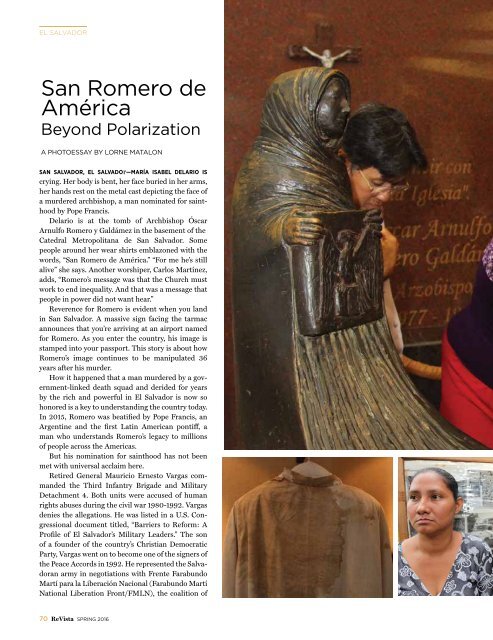EL SALVADOR
8clowSgZh
8clowSgZh
Create successful ePaper yourself
Turn your PDF publications into a flip-book with our unique Google optimized e-Paper software.
<strong>EL</strong> <strong>SALVADOR</strong><br />
San Romero de<br />
América<br />
Beyond Polarization<br />
A PHOTOESSAY BY LORNE MATALON<br />
SAN <strong>SALVADOR</strong>, <strong>EL</strong> SALVADOr—MARÍA ISAB<strong>EL</strong> D<strong>EL</strong>ARIO IS<br />
crying. Her body is bent, her face buried in her arms,<br />
her hands rest on the metal cast depicting the face of<br />
a murdered archbishop, a man nominated for sainthood<br />
by Pope Francis.<br />
Delario is at the tomb of Archbishop Óscar<br />
Arnulfo Romero y Galdámez in the basement of the<br />
Catedral Metropolitana de San Salvador. Some<br />
people around her wear shirts emblazoned with the<br />
words, “San Romero de América.” “For me he’s still<br />
alive” she says. Another worshiper, Carlos Martínez,<br />
adds, “Romero’s message was that the Church must<br />
work to end inequality. And that was a message that<br />
people in power did not want hear.”<br />
Reverence for Romero is evident when you land<br />
in San Salvador. A massive sign facing the tarmac<br />
announces that you’re arriving at an airport named<br />
for Romero. As you enter the country, his image is<br />
stamped into your passport. This story is about how<br />
Romero’s image continues to be manipulated 36<br />
years after his murder.<br />
How it happened that a man murdered by a government-linked<br />
death squad and derided for years<br />
by the rich and powerful in El Salvador is now so<br />
honored is a key to understanding the country today.<br />
In 2015, Romero was beatified by Pope Francis, an<br />
Argentine and the first Latin American pontiff, a<br />
man who understands Romero’s legacy to millions<br />
of people across the Americas.<br />
But his nomination for sainthood has not been<br />
met with universal acclaim here.<br />
Retired General Mauricio Ernesto Vargas commanded<br />
the Third Infantry Brigade and Military<br />
Detachment 4. Both units were accused of human<br />
rights abuses during the civil war 1980-1992. Vargas<br />
denies the allegations. He was listed in a U.S. Congressional<br />
document titled, “Barriers to Reform: A<br />
Profile of El Salvador’s Military Leaders.” The son<br />
of a founder of the country’s Christian Democratic<br />
Party, Vargas went on to become one of the signers of<br />
the Peace Accords in 1992. He represented the Salvadoran<br />
army in negotiations with Frente Farabundo<br />
Martí para la Liberación Nacional (Farabundo Martí<br />
National Liberation Front/FMLN), the coalition of<br />
70 ReVista SPRING 2016


